
Looking at food ingredient labels,
is like checking the specifications and configurations when buying a phone or computer.
The production process, nutritional value, and cost-effectiveness of food can be clearly understood.
Therefore, knowing how to read food ingredient labels is very necessary.
The Composition of Food Ingredient Labels
Answerer @Sesame Sauce(64k+ likes) agrees.
I believe that in today’s society where packaged food is so common, knowing how to read food ingredient labels should be equivalent to the ancient skill of recognizing the five grains.
If you don’t recognize the five grains, it doesn’t affect your life at all. But if you can’t understand the nutritional ingredient label, you can only rely on your eyes when shopping, flipping the package back and forth just to check the production date.
Let’s put it this way, relying on your eyes is not reliable at all; it can be said that there are traps everywhere. Why not understand food ingredient labels? I believe this knowledge is urgently needed to be popularized in food science for the public and should be taught to children as soon as possible.
A coarse grain bread, with a brown color that looks primitive, seems to be made from coarse grains, but upon checking the ingredient list: oh dear! Wheat flour is the first ingredient, and there is hardly any coarse grain, just a bit of cocoa powder for color!
…
Such examples are countless.
Next, I will teach you how to read the labels on pre-packaged foods, and I will try to explain it in a simple and understandable way. When you get a pre-packaged food, flip it over to look at the back label, focusing mainly on two parts: the ingredient list and the nutritional information.
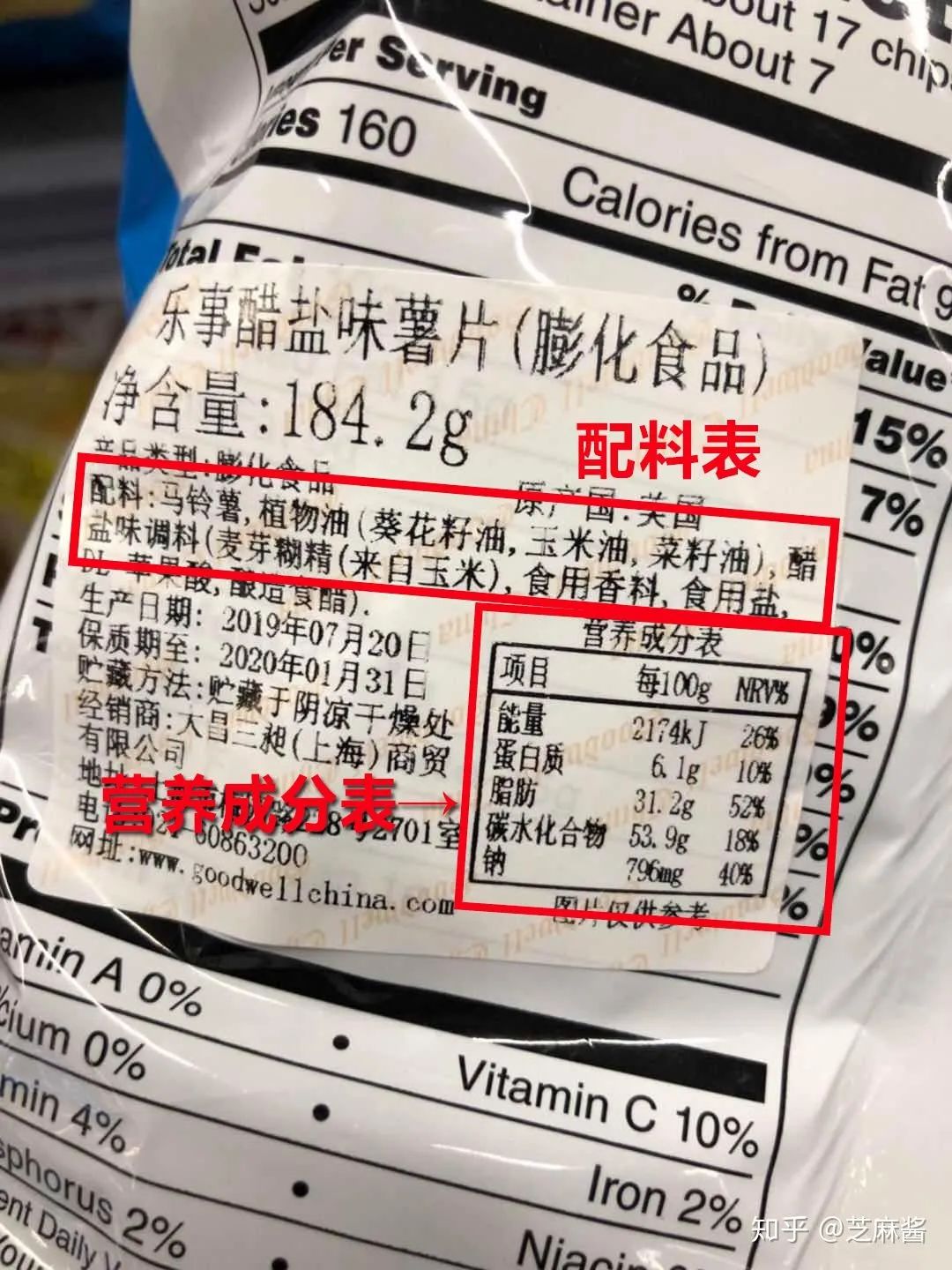
Ingredient List
The most important knowledge point about the ingredient list is: the order of the ingredients is based on their weight in the food, with the first item being the most abundant. Therefore, we see that in beverage ingredient lists, the first item is mostly water, the second is white sugar, followed by various flavorings and food additives.
When you see some unhealthy elements like white sugar, high fructose syrup, and fats, especially hydrogenated vegetable oil, appearing in the top three items, be cautious; this food may not be healthy. To know the true ingredients of a food, your eyes often cannot tell, but if you learn to read the ingredient list, the food cannot deceive you based on appearance.
For example, because modern people think coarse grains are healthier, producers use tricks when making bread or dry noodles to make the food appear more “coarse grain”:
First trick: Use regular flour + wheat bran to mimic the rough texture of whole wheat flour.
Second trick: Use cocoa powder or food coloring to deepen the color to mimic whole grain or rye foods. At this point, you just need to check if the proportion of whole wheat flour is greater than that of wheat flour in the ingredient list, and whether there are coloring ingredients like cocoa powder or caramel color to distinguish.
A truly 100% whole wheat bread will only use whole wheat flour as the ingredient. However, it is not necessary to be too strict; the combination of wheat flour + bran has a much better texture than 100% whole wheat and contains a high amount of dietary fiber, making it healthier than white bread, and it is still a good choice.
Concerns about sugar and fat are also reflected in the ingredient list:
“Sugar”, whether it is white sugar, high fructose syrup, or artificial sweeteners, can be seen in the order of appearance.
“Fat”, does this cake use vegetable cream or animal cream? The ingredient list states whether it is butter, animal cream, or vegetable oil, hydrogenated vegetable oil? Are there trans fats? Is it at the top or bottom of the list? (Note: Hydrogenated vegetable oil is only suspected of containing trans fats; it does not necessarily contain trans fats, as modern processes can produce hydrogenated vegetable oil with zero trans fats.)
As for food additives, I won’t go into too much detail as it is too complex; just to say that reasonably and legally used additives are safe, and there is no need to be afraid when seeing a bunch of unfamiliar additives.
Nutritional Information
Looking at the ingredient list only tells you what raw materials are present and their general order, but to assess the nutritional value of a food, you must look at the nutritional information.
The nutritional information is a concise table with three vertical columns.
First column: Item
According to national standards, most foods must label five basic items, which we can simply remember as “1+4”: 1 is energy or calories, and 4 are four basic energy substances: protein, fat, carbohydrates, and sodium.
Below is a typical nutritional information table that includes only the 1+4 basic items:
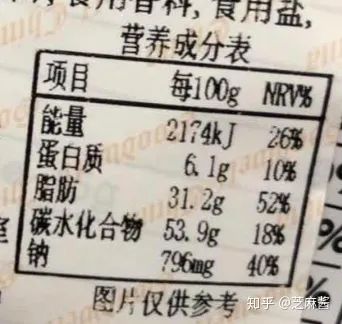
Second column: Content
The second column indicates the content of each item per 100g (for solid foods) or per 100ml (for liquid foods) or per serving (for example, a package of food weighing less than 100g is often labeled according to the actual weight of that package).
From this ingredient table, we can see that per 100g of this food, there is energy 2174kJ, protein 6.1g, fat 31.2g, carbohydrates 53.9g, and sodium 796mg. It is important to note that the general energy unit in China is kilojoules (kJ), so all foods sold in China will have their energy listed in kilojoules (kJ), while the common energy unit in the United States is calories, kilocalories, or large calories. In practical use, apart from the food industry and some academic research still using kilojoules (kJ), most other scenarios have long been accustomed to saying kilocalories. To convert kilojoules to kilocalories, divide by 4; for example, 2174kJ divided by 4 is approximately 543 kilocalories.
Returning to this table, there is a question I wonder if you have noticed: assuming a person who has not studied food nutrition sees the second column, it actually has no meaning; 6g of protein in 100g, who knows what that means? Is it high or low in food? We don’t know.
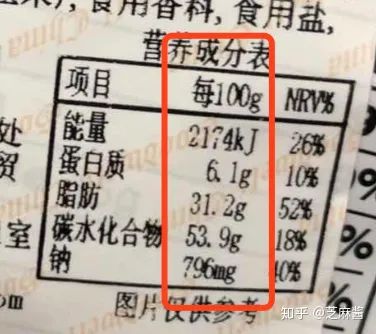
Third column: Nutrient Reference Value (NRV)
Now we need to look at the third column, the Nutrient Reference Value (NRV), which is a place where many people get confused: “Why does this percentage add up to more than 100%?” and “Why can the percentage of a single nutrient be 120%?” You can see that in this image, the third column adds up to more than 100%.
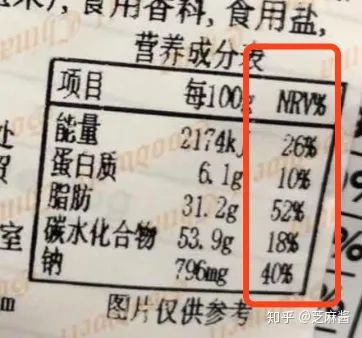
Don’t be confused; that percentage does not represent the percentage of this element in the weight of the food, but rather the “percentage of your recommended daily intake”. Adding them up has no meaning. In simple terms, if you need 100g of protein daily, and this food contains 20g of protein per 100g, then the third column will show 20%. This tells you: by eating 100g of this food, you have reached 20% of your daily protein requirement. If the NRV% shows 120%, it means that by eating 100g of this food, you have exceeded the recommended value for that nutrient by 20%, meaning you have eaten too much.
Through this percentage, you can assess the nutritional value of this food; this design is quite scientific, but you need to know how to use it.
Five Indicators That Weight Watchers Must Look At
Answerer @Penguin Eating Guide(9k+ likes) agrees.
You may pay attention to the most basic nutritional information (energy, protein, fat, carbohydrates, sodium) to varying degrees, but there are many traps hidden by businesses, especially unfriendly to those trying to lose weight, so we need to clarify them one by one.
Per 100g or Per Serving?
Be sure to pay close attention to the unit of the ingredient list: is it per 100g or per serving? Some high-calorie products are really cunning: they change the calculation method to per serving, and if you are careless and don’t notice, you might think the calories are quite nice. When you convert the serving size to 100g, the data can be shocking.
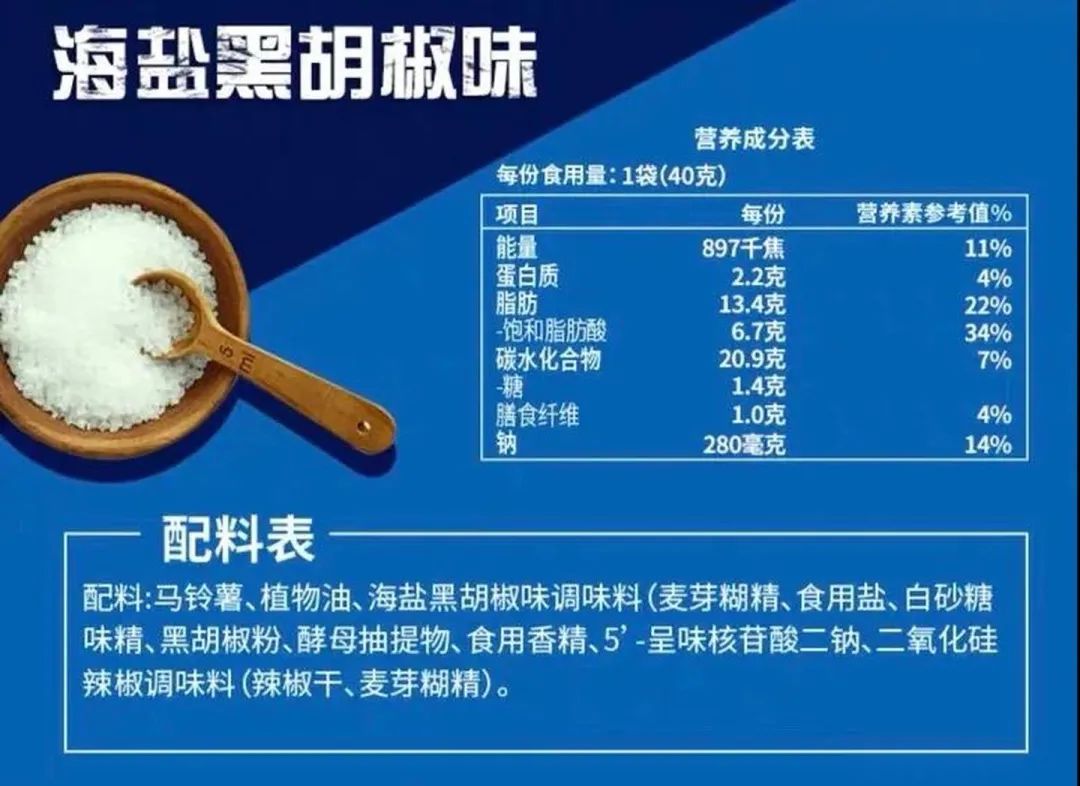
kJ or Cal?
Is the energy unit kJ or Cal? Those worried about gaining weight must check.
Most foods in China are labeled in kJ (kilojoules), which is quite different from the calories we commonly refer to. There is a simple conversion method:1kCal is approximately equal to 4kJ.
The three macronutrients produce energy with different efficiencies:
1g of protein = 17kJ ≈ 4kCal
1g of carbohydrates = 16kJ ≈ 4kCal
1g of fat = 37kJ ≈ 9kCal
Fat has the highest energy production efficiency, so you know why everyone craved fatty meat during famine, right?
Are There Trans Fats?
Try to buy less of those that contain trans fats. Among fats, the most concerning is trans fats. They are produced by the incomplete hydrogenation of vegetable oils and increase the risk of cardiovascular diseases, and must be clearly labeled on packaging.
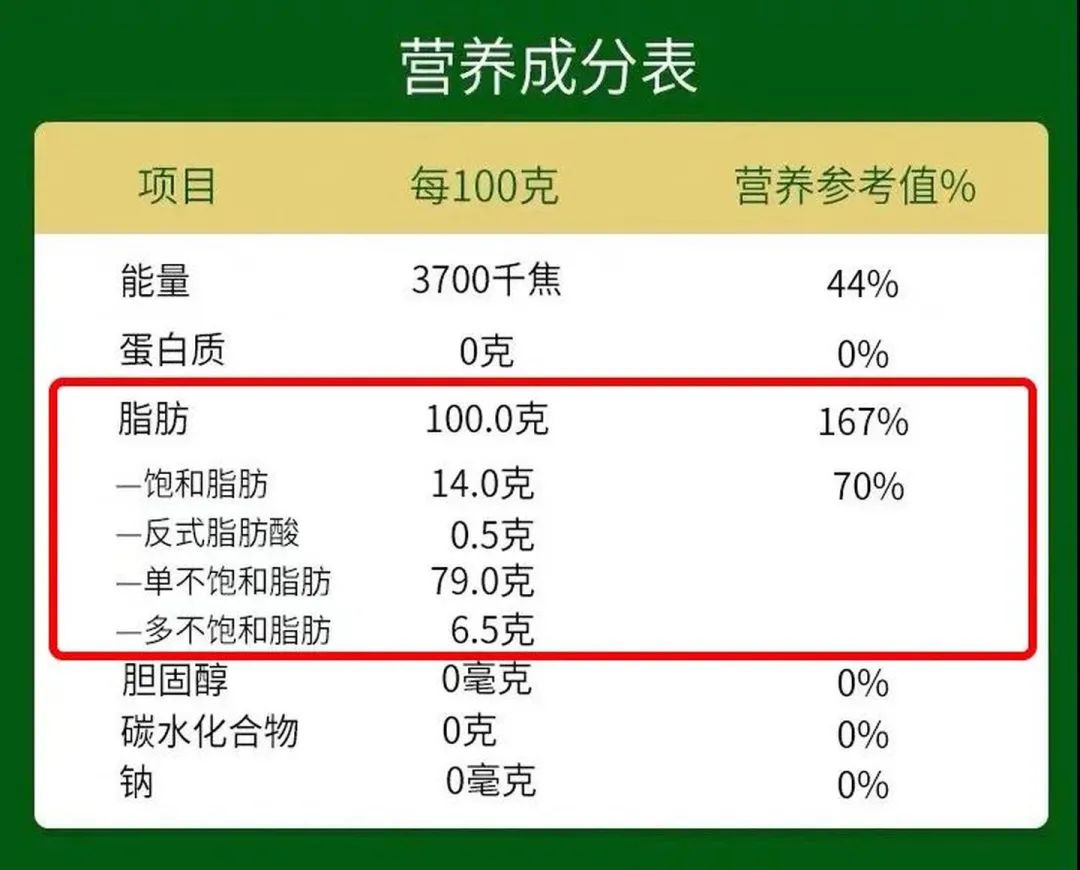
You may ask, why hydrogenate good vegetable oil? Because butter and cream were too expensive back then, people discovered that by catalyzing vegetable oil, it could also become solid at room temperature, replacing animal cream and butter, hence it is also called margarine or artificial butter.To extend this knowledge: sometimes trans fats are labeled as 0, but remember to check the ingredient list for terms like “hydrogenated/partially hydrogenated, margarine, shortening, cocoa butter substitute, vegetable fat powder, mono- and diglycerides”.
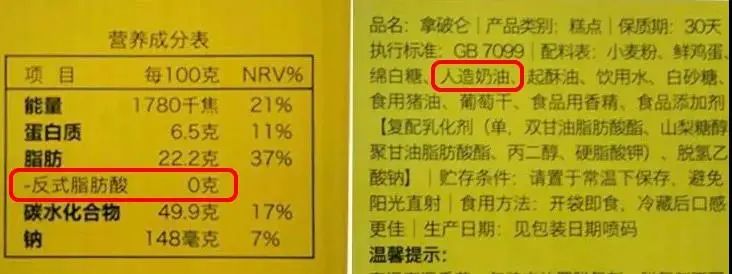
By the way, some businesses use cheap palm oil to avoid hydrogenated vegetable oil. However, palm oil has a saturated fat content of up to 50%, which is even higher than lard, making it a sure way to gain weight, and consuming it is also unhealthy.
Never Ignore Sodium
Remember to take a look at sodium, which is often overlooked.Long-term excessive sodium intake can lead to high blood pressure, so the World Health Organization recommends a daily sodium intake of 2g for adults.
What does this mean? If all the sodium you consume in a day comes from salt, it translates to only being able to consume 5g of salt daily, which is about the amount in a bottle cap of mineral water.
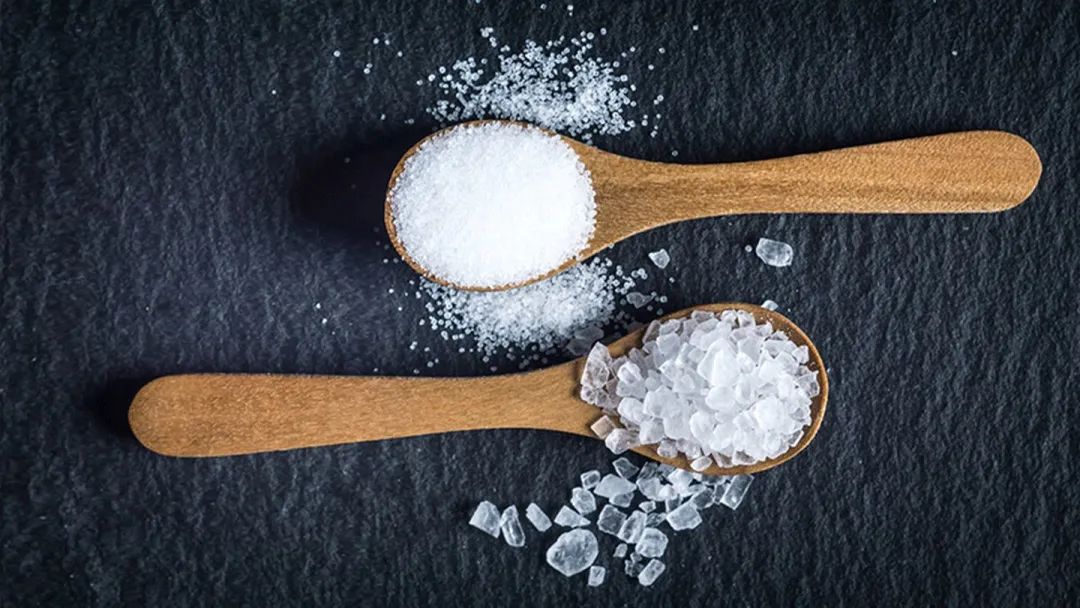
It is important to know that sodium comes not only from salt, oyster sauce, soy sauce, and monosodium glutamate, but also from foods like noodles, dumpling skins, and dried shrimp.
Even if you usually cook lightly, snacking can easily lead to excessive sodium intake… Foods with names like “pepper salt” or “sea salt” contain a lot of sodium. Snacks like soda crackers, dried squid, and meat jerky, while rich in protein, also have high sodium content.

Generally speaking, “low sodium foods” refer to those with sodium content below 120mg per 100g. Next time you choose snacks, remember to pay attention to this column.
Learn to Read NRV%
Finally, learning to read NRV% is very important; it can tell you whether a food is low-calorie and healthy.NRV% (Nutrient Reference Value) is often overlooked, but it is very significant.
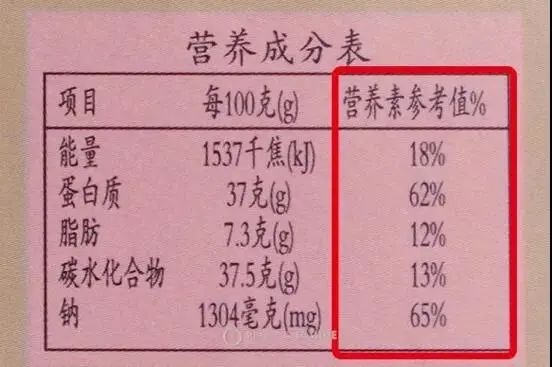
This percentage indicates the proportion of various nutrients in the food relative to the recommended daily intake for a healthy adult.In simpler terms, it tells you how much of your daily recommended intake this food accounts for. It is almost like a nutritionist directly telling you whether you have consumed too much or too little of this nutrient today.
Weight watchers should focus on energy, carbohydrates, and fat in these columns. For example, this small snack, if you eat 100g, will use up 62% of your fat quota for the day, which is scarier than a horror movie!
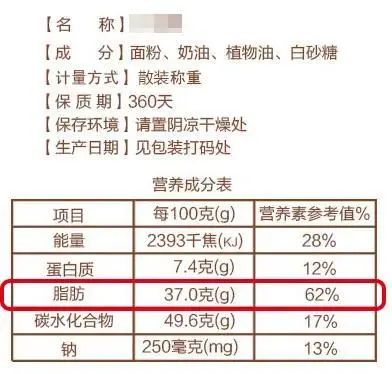
NRV% is also an important basis for judging the nutritional density of food. A common tip is: if you divide the protein NRV% by the energy NRV%, and the result is ≥1, then you can consider that this food has a high protein density.
For more content, search “Zhihu”

Interactive Topic Have you ever been misled by food ingredient labels?Feel free to share your experiences with us~ Popular Articles from Zhihu Laboratory
Popular Articles from Zhihu Laboratory


*End of Article Surprise*Long press to scan the code to enter “Zhihu Laboratory”, reply“Read” to receive a free copy of the Zhihu Weekly.


